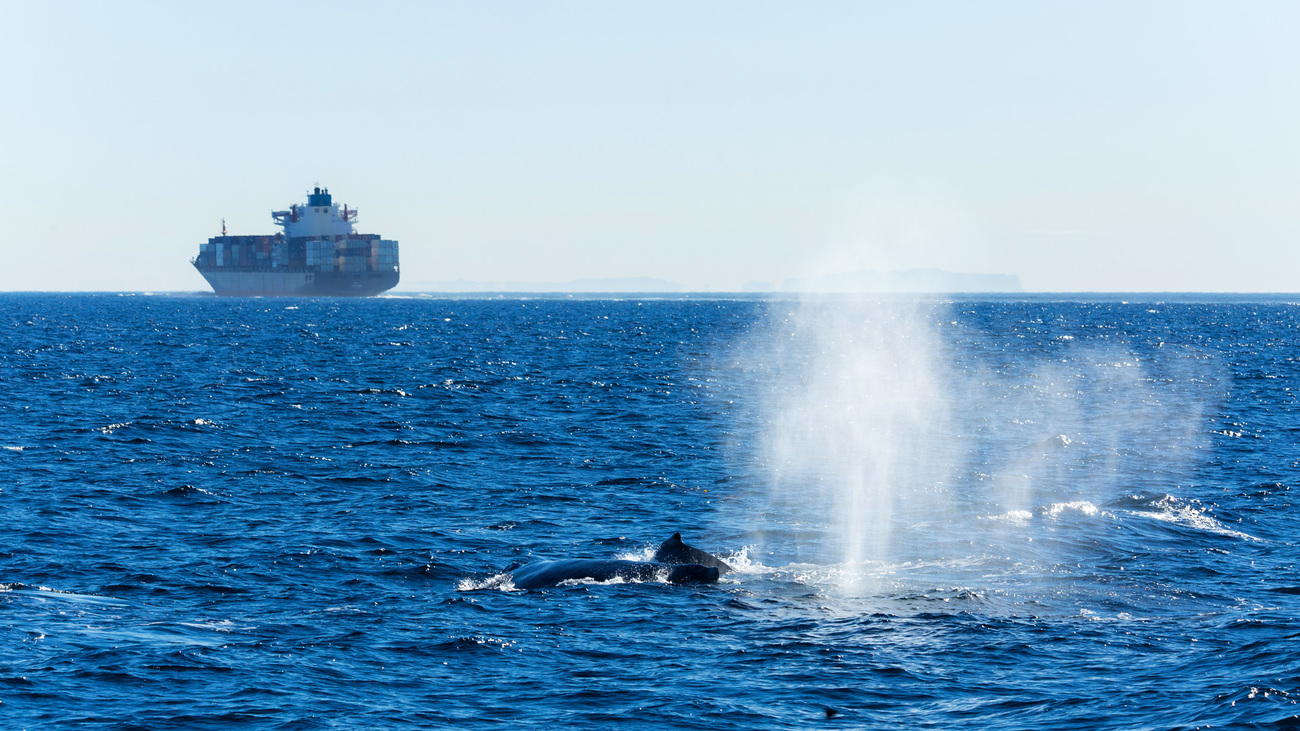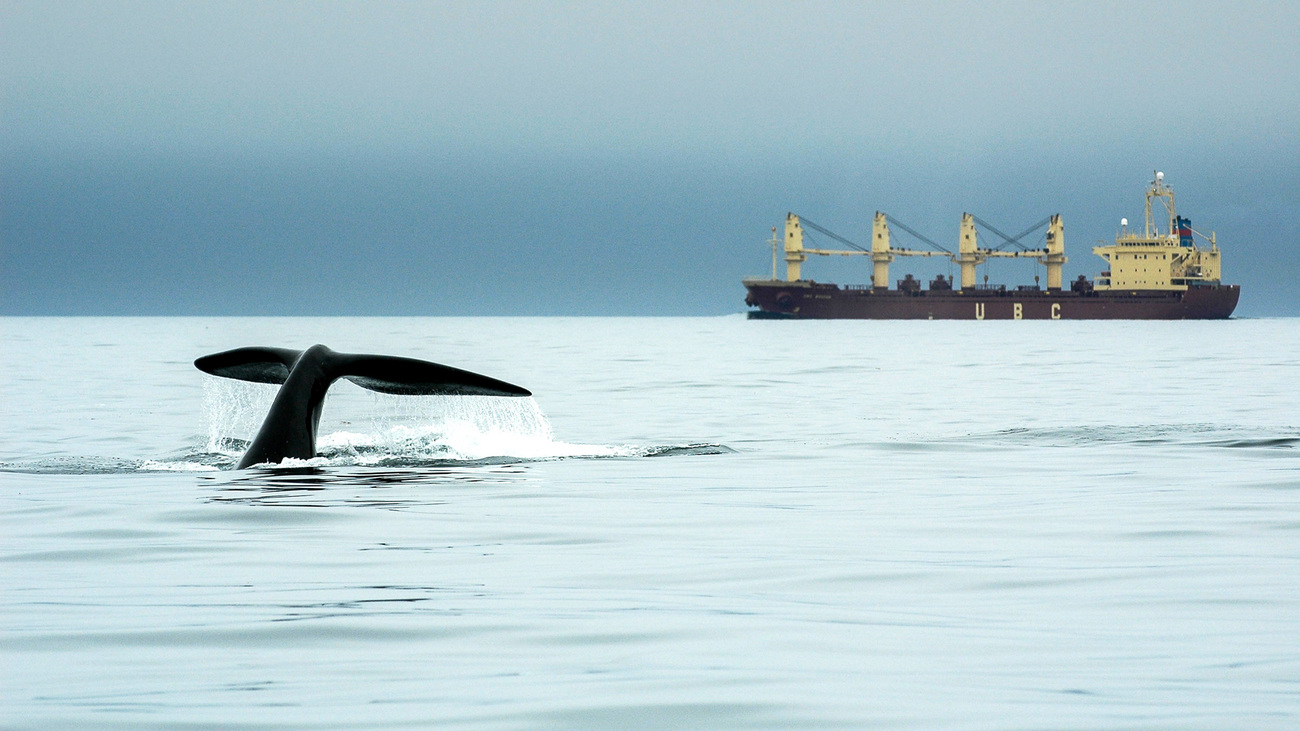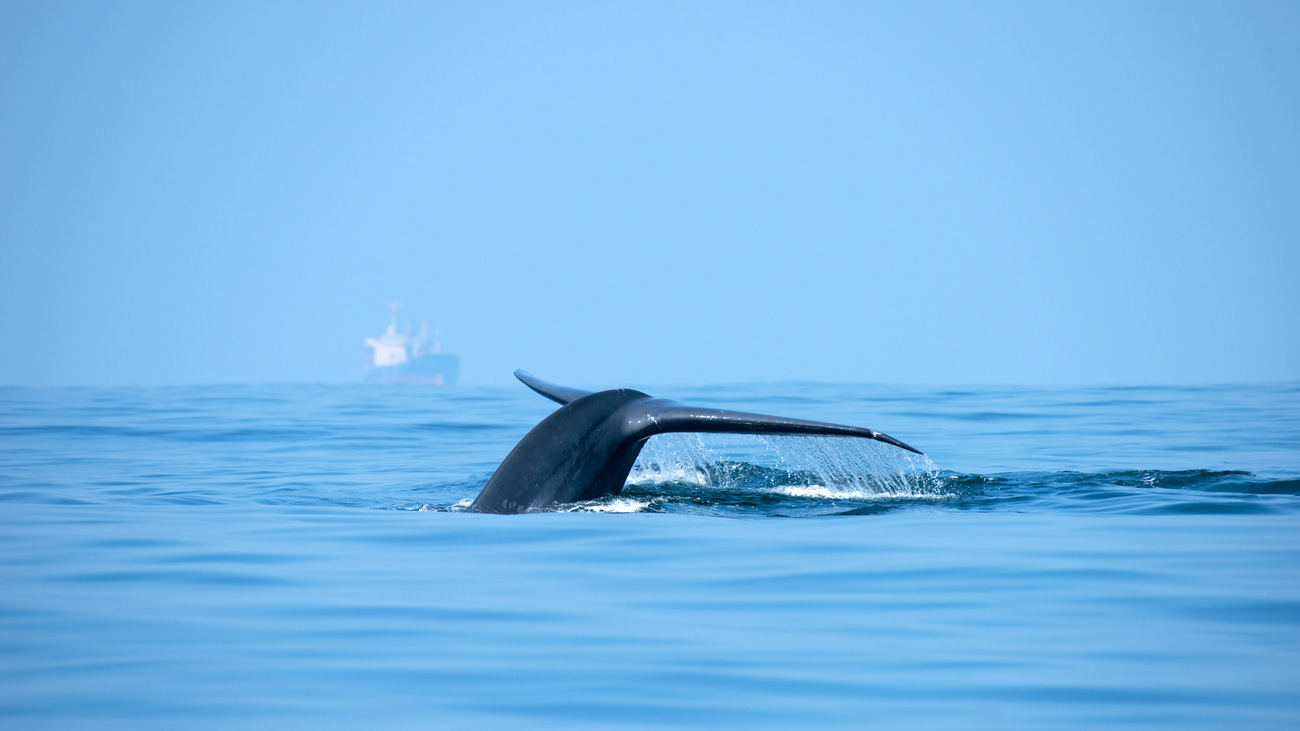Ocean Noise Reduction - Global
Saving marine life could be as easy as turning down the volumeOcean noise pollution: What is it and why is it a problem?
Ocean noise pollution: What is it and why is it a problem?
Ocean noise pollution is a type of pollution that negatively affects marine life. Despite disturbing, harming, and sometimes even killing a wide range of marine animals, there are still no international legal regulations on this type of pollution—and IFAW wants to change that.

Read on to learn exactly what ocean noise pollution is, how it affects marine life, and what we can do to help reduce its impact on the ocean and animals.
What is ocean noise pollution?
Ocean noise pollution is a form of environmental pollution caused by human activities—like commercial shipping, oil exploration, seismic surveys, offshore wind turbine installation, and military sonar—that generate unnatural and excessive sound underwater. For marine mammals in particular, this noise pollution can interfere with and obscure their ability to hear natural sounds in the ocean, which can disrupt their natural behaviours and interfere with their ability to communicate.
Increased background noise in the ocean is a direct result of the upwards of 250,000 vessels travelling across the global ocean at any one time. Cargo ships can emit as much as 190 decibels of noise, which is much louder than a plane taking off and about the same noise level as a rock concert. Noise also travels much faster in water than in air, meaning the increased noise levels affect animals and habitats far and wide.
Why is ocean noise pollution a problem?
Marine life is affected by ocean noise pollution in many ways.
It impedes communication
Many animals, including dolphins, whales, and fish, use vocalisations to communicate. When consistent unnatural noise masks these calls, it becomes harder for the animals to hear and find each other, coordinate hunts, and detect and warn others about predators.
It disorientates animals
Ocean noise is especially problematic for animals that rely on echolocation, like dolphins and toothed whales. Excessive noise can disrupt these signals, causing the animal to become disoriented and unable to hunt successfully.
It can cause injury
As well as disturbing essential life activities, noise can also indirectly cause injury. Military sonar and seismic air guns are high intensity and excessively loud, and can send animals into a panic. To get away from the noise, they might ascend too quickly, leading to decompression sickness and skin damage from gas bubble lesions. In some cases, loud sounds can cause hearing loss or even cause animals to strand and die.
It impacts the entire marine ecosystem
As ecosystems in the ocean are so complex and interconnected, the direct effects of noise pollution on one species will indirectly affect another. For instance, if a whale strands on a beach in response to sudden, intense noise from a human activity, the whale dies on land instead of at sea, and its body doesn’t sink to the sea floor as it normally would. The seafloor-dwelling animals that rely on the whale’s body for food and sustenance then lose a key food source.
What animals are most impacted by ocean noise?

All marine life is impacted by ocean noise to some extent, but marine mammals like whales and dolphins are particularly affected. Underwater noise pollution can change their behaviour in multiple ways. It can drive them out of important feeding or breeding grounds or force them to alter their migration routes. This may put them at risk of getting trapped in sea ice or encountering predators.
Ocean noise also affects communication. In some areas, dolphins and whales have changed their calls in an attempt to be heard over noise pollution. These new vocalisations make it harder for members of the same species to recognise each other and find mates. It also makes it more difficult to communicate that predators or prey are nearby.
Dolphins, who rely on echolocation to hunt and navigate, can also get separated from their pods due to ocean noise. This results in the displacement or fragmentation of dolphin populations, making it harder for these marine mammals to hunt and reproduce successfully.
Unfortunately, loud ocean noise like naval anti-warfare sonar can also directly injure whales and dolphins. If the animals panic and try to escape the sonar noise too quickly, they can become stranded or suffer from decompression sickness by surfacing too quickly. Haemorrhaging to the heart and brain can also occur within four hours of being exposed to this kind of sonar.
Fish, squid, crustaceans, and sea turtles are affected by ocean noise pollution, too. It can trigger stress responses in fish, disturb nesting habits, affect coordination and navigation, and damage their hearing. Seismic surveys—used to map offshore oil and natural gas fields by blasting the seas with powerful airguns at 10-second intervals and measuring the echoes off the seafloor—are known to severely damage the internal organs of giant squid, for example. This process can also kill zooplankton within a radius of 1.2 kilometres of each shot. The response of sea turtles to ocean noise pollution has not been extensively studied, but we know that airgun surveys have caused temporary hearing damage in these animals.
Legal regulations on ocean noise pollution
There are currently no international standards for the regulation of ocean noise pollution. Instead, local governments and even individual ports have established their own regulations. For instance, the Port of Vancouver offers discounts to vessels that voluntarily comply with their environmental guidelines. In the European Union, mandatory thresholds have recently been set for underwater noise to ensure species and habitats are protected from this pollutant. EU Member States will now include these thresholds in their updated marine strategies and take action to ensure noise in their waters does not exceed these limits.
International institutions are beginning to take notice, though. The United Nations Convention on the Law of the Sea (UNCLOS) is the most wide-reaching agreement on maritime activity, with 168 participating countries. Article 211 of UNCLOS seeks to prevent and reduce pollution of the marine environment from vessels, though it doesn’t specify exactly what its member countries should do to achieve this.
The International Maritime Organization (IMO), a specialised agency of the United Nations responsible for regulating maritime transport, has also established guidelines for the reduction of underwater radiated noise from shipping to address adverse impacts on marine life. These guidelines include possible strategies for noise reduction in design, construction, modification and/or operation (like ship speed reduction). However, the original guidelines were unfortunately not widely adopted by industry members. A revised version of the guidelines has therefore been developed to both increase uptake and monitor effectiveness. The IMO also approved an experience-building phase (EBP) starting in 2023 to collect information on best practices and lessons learned from the application of these underwater noise guidelines.
At IFAW, we’re looking to create a safer and quieter ocean by reducing noise pollution through lower speeds for ships and other marine vessels travelling to and from European ports. Globally, by reducing ship speeds by approximately 10%, we could:
- Reduce ocean noise pollution by 40%
- Reduce the risk of ships colliding with whales by 50%
- Lower greenhouse gas emissions from shipping by 13%
These are significant outcomes for such a small change, and we believe this initiative would go a long way to protecting marine life. Sign IFAW’s petition to encourage EU institutions to adopt Blue Speeds.
How can we reduce ocean noise pollution?

At IFAW, we have been advocating for the regulation of underwater noise for many years. Our Blue Speeds campaign aims to reduce ship speeds in Europe, and over 100,000 people have signed our petition so far.
Thanks to the efforts of organisations like IFAW, the European Commission recently set a mandatory cap on underwater noise from human activities at sea. The threshold, set by a group of underwater noise experts, will help reduce the impacts on marine life. It’s up to each Member State to decide what methods they’ll use to ensure they don’t exceed the limits, and we’re advocating for our Blue Speeds initiative as a practical and easily implementable solution.
Because there are lots of different sources of ocean noise pollution, there are also a lot of ways to reduce it. What we do know is that the best way to address underwater noise is to reduce noise at the source. So for seismic surveys, this means using emerging quieter technologies like ‘marine vibroseis’ as an alternative to airguns; for shipping, this means achieving better maintenance and optimisation of the propeller design and slowing ships down to reduce noise at the source; and for the renewable energy sector, this means using alternatives to conventional pile driving that have much lower noise levels.
However, many countries and organisations are reluctant to start adopting noise-reducing solutions because they take up time and resources. That’s why creating international regulations would have a greater impact, as their adoption would be mandatory. If you agree, sign our petition and consider donating to support our efforts to achieve international standards for ocean noise reduction.
Related content
Every problem has a solution, every solution needs support.
The problems we face are urgent, complicated, and resistant to change. Real solutions demand creativity, hard work and involvement from people like you.